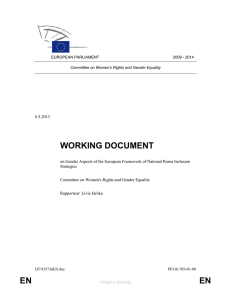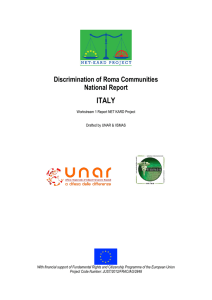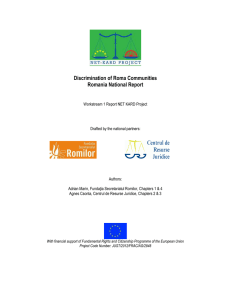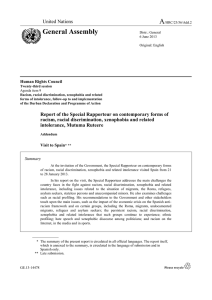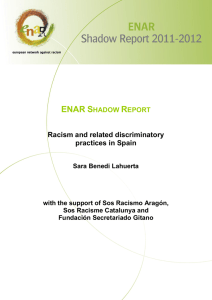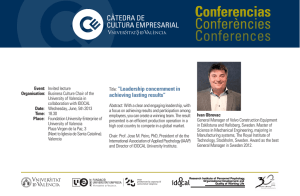White Paper on abuses and rights violations of
Anuncio
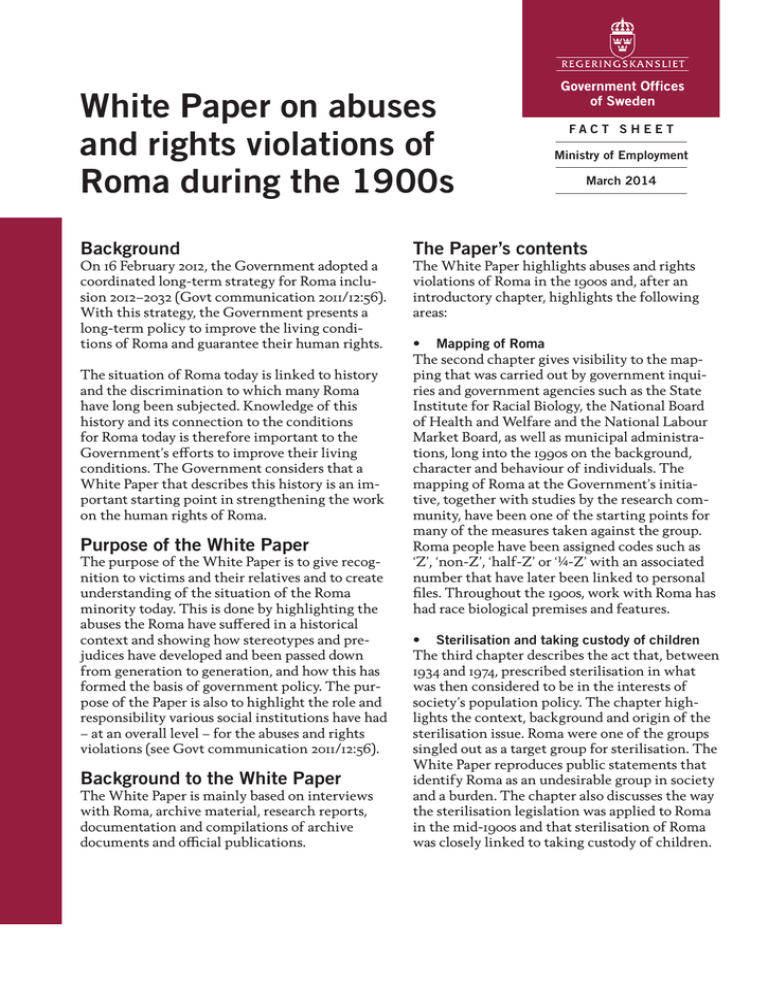
White Paper on abuses and rights violations of Roma during the 1900s Background On 16 February 2012, the Government adopted a coordinated long-term strategy for Roma inclusion 2012–2032 (Govt communication 2011/12:56). With this strategy, the Government presents a long-term policy to improve the living conditions of Roma and guarantee their human rights. The situation of Roma today is linked to history and the discrimination to which many Roma have long been subjected. Knowledge of this history and its connection to the conditions for Roma today is therefore important to the Government’s efforts to improve their living conditions. The Government considers that a White Paper that describes this history is an important starting point in strengthening the work on the human rights of Roma. Purpose of the White Paper The purpose of the White Paper is to give recognition to victims and their relatives and to create understanding of the situation of the Roma minority today. This is done by highlighting the abuses the Roma have suffered in a historical context and showing how stereotypes and prejudices have developed and been passed down from generation to generation, and how this has formed the basis of government policy. The purpose of the Paper is also to highlight the role and responsibility various social institutions have had – at an overall level – for the abuses and rights violations (see Govt communication 2011/12:56). Background to the White Paper The White Paper is mainly based on interviews with Roma, archive material, research reports, documentation and compilations of archive documents and official publications. FACT SHEET Ministry of Employment March 2014 The Paper’s contents The White Paper highlights abuses and rights violations of Roma in the 1900s and, after an introductory chapter, highlights the following areas: • Mapping of Roma The second chapter gives visibility to the mapping that was carried out by government inquiries and government agencies such as the State Institute for Racial Biology, the National Board of Health and Welfare and the National Labour Market Board, as well as municipal administrations, long into the 1990s on the background, character and behaviour of individuals. The mapping of Roma at the Government’s initiative, together with studies by the research community, have been one of the starting points for many of the measures taken against the group. Roma people have been assigned codes such as ‘Z’, ‘non-Z’, ‘half-Z’ or ‘¼-Z’ with an associated number that have later been linked to personal files. Throughout the 1900s, work with Roma has had race biological premises and features. • Sterilisation and taking custody of children The third chapter describes the act that, between 1934 and 1974, prescribed sterilisation in what was then considered to be in the interests of society’s population policy. The chapter highlights the context, background and origin of the sterilisation issue. Roma were one of the groups singled out as a target group for sterilisation. The White Paper reproduces public statements that identify Roma as an undesirable group in society and a burden. The chapter also discusses the way the sterilisation legislation was applied to Roma in the mid-1900s and that sterilisation of Roma was closely linked to taking custody of children. • Entry ban and regulated immigration The fourth chapter describes the act that singled out and prescribed an entry ban on Roma. The motivation behind the ban was the notion that Roma did not fit into society and were therefore undesirable. In many respects, the policy that took effect after 1954, when the entry ban on Roma was abolished, was based on the idea that there should not be too many Roma in Sweden. Roma outside of Sweden were defined as ‘socially handicapped’ and were considered to live a life that required the need for measures to ‘adjust and adapt’ the group. • Access of Roma to housing The fifth chapter gives visibility to the way access of Roma to housing was affected by the fact that municipalities prevented and obstructed the opportunities of Roma to settle permanently and the effects this had on the situation of Roma in general. The chapter describes municipal practices of not registering Roma in the census, urging Roma to move on and putting conditions on housing. • Access of Roma to education The sixth chapter highlights the approaches that affected access of Roma to education and the reasons and methods that led to Roma children being placed in remedial classes or special needs classes. A common thread that ran through the 1900s was the notion that the opportunities for equal quality education were limited by the Roma themselves and that it was not considered possible to resolve school-related problems without measures that also aimed at changing the Roma. visions. The aim was to impede or prevent the opportunities for Roma to support themselves, and one result was that Roma were pushed farther out of society into a position that was even more marginalised. Many of the measures were based on the persistent perception that Roma are to blame for their own situation. One aspect of this laying of blame is that public authorities allowed both the analysis of the lack of improvements and incentives for action to result in the notion that the problem rested with the group. • Concluding discussion The White Paper covers a period of over 100 years. The review of political motives and measures during the first half of the 1900s shows that registration, sterilisation, taking custody of children, expulsion and the refusal to register Roma in the census were motivated and carried out on the assumption that Roma were undesirable. The measures made the life of the Roma more difficult. At the same time, the very perception that Roma were not a part of society was also a motive as to why measures that targeted the group were necessary. One characteristic shared by many of the political measures during the second half of the 1900s is that they were reform oriented. Roma were allowed to acquire housing. At the same time, many of the measures were aimed at saving the Roma from their inferior lifestyle to a life within the framework of society’s social services. In many respects, the edifying features have marked the measures and resulted in a far-reaching intervention in the lives of individuals. • Access of Roma to work The seventh chapter presents some of the regulations, norms and conduct that have obstructed the opportunities for Roma to support themselves, which not only resulted in repercussions in working life but in the overall life situation of Roma. The consequences were not unknown to those who formulated and applied the pro- Ministry of Employment Sweden SE-103 33 Stockholm, Sweden Phone switchboard +46 8 405 10 00 All inquiries about content should be directed to the Division for Discrimination Issues, tel +46 8 405 10 00. Additional copies of the fact sheet can be ordered from the Ministry of Employment, tel +46 8 405 10 00. The Government’s website: http://www.sweden.gov.se/ Fact sheet produced by the Ministry of Employment. Printed by Grafisk Service, Stockholm, Sweden, March 2014. Article no. A14.003
